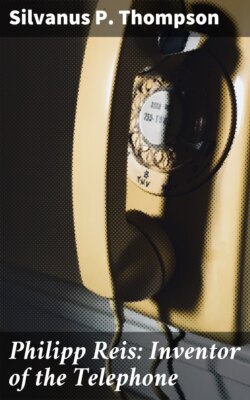Читать книгу Philipp Reis: Inventor of the Telephone - Silvanus P. Thompson - Страница 15
На сайте Литреса книга снята с продажи.
Tenth Form.—The Square Box.
ОглавлениеFig. 17.
Fig. 18.
The last form of Reis’s Transmitter is that which has become best known, being the only one (except Fig. 9) which found its way into the market. It is here named, for the sake of distinction, as the “Square Box” pattern. It consisted of a square wooden box, having a hinged lid. Fig. 17 is reproduced from Reis’s “Prospectus” (see page 85), whilst Fig. 18 is taken from Prof. Schenk’s biographical pamphlet.
In this instrument the idea of the human ear is still carried out. The tin funnel, with its flaring embouchure, still represents the auditory tube and pinna. The tympanum, no longer at the very end of the tube, is strained across a circular aperture in the lid. Upon it rests the strip of platinum foil which serves as an electrode, and resting in loose contact with this lies the little angular piece of metal which Reis called the “Hämmerchen.” Above all lay a circular glass disk (a cover to keep out the dust), which was removed when the instrument was used. So sensitive did this form prove itself that it was found unnecessary to speak right into the mouthpiece, and the speaker in practice talked or sang with his mouth at some little distance vertically above the instrument; a method which had the advantage of not so soon relaxing the membrane by the moisture of the breath. The figures show also the auxiliary apparatus attached at the side, consisting of a key for interrupting the circuit (added at first to enable the experimenters to single out the “galvanic tones” from the reproduced tones, and later applied, as Reis explains in his “Prospectus,” on page 87), and an electro-magnet to serve as a “call,” by which the listener at the other end could signal back to the transmitter.
This form of instrument, which has been so frequently described in the Text-books of Physics, was constructed for sale first by Albert of Frankfort, later by Ladd of London, König of Paris, and Hauck of Vienna. Further details concerning it will be found in this book, in Reis’s “Prospectus,” and in other contemporary documents.
Although this form is the one most commonly referred to as “the Reis Telephone,” it is evident from a consideration of the entire group of forms that Reis’s invention was in no way limited to one individual pattern of instrument. For in all these forms there was embodied one all-embracing principle;—that of controlling the electric current by the voice working upon a point of imperfect contact, by the agency of a tympanum, thereby opening or closing the circuit to a greater or less degree, and so regulating the flow of the current.
